Exam Question for Class 12 Mathematics Chapter 5 Continuity and Differentiability
Please refer to below Exam Question for Class 12 Mathematics Chapter 5 Continuity and Differentiability. These questions and answers have been prepared by expert Class 12 Mathematics teachers based on the latest NCERT Book for Class 12 Mathematics and examination guidelines issued by CBSE, NCERT, and KVS. We have provided Class 12 Mathematics exam questions for all chapters in your textbooks. You will be able to easily learn problems and solutions which are expected to come in the upcoming class tests and exams for standard 10th.
Chapter 5 Continuity and Differentiability Class 12 Mathematics Exam Question
All questions and answers provided below for Exam Question Class 12 Mathematics Chapter 5 Continuity and Differentiability are very important and should be revised daily.
Exam Question Class 12 Mathematics Chapter 5 Continuity and Differentiability
Very Short Answer Type Questions
Question. Find the value of k so that the following function is continuous at x = 2.

Answer. ∵ f(x) is continuous at x = 2

Question. Find the relationship between a and b so that the function ‘f ’ defined by

Answer. ∵ f(x) is continuous at x = 3
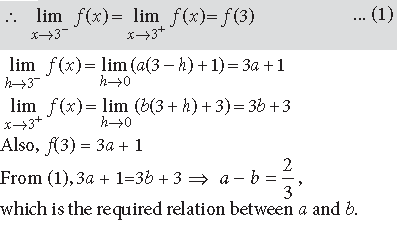
Question. Discuss the continuity of the function f(x) at x = 1/2, when f(x) is defined as follows:
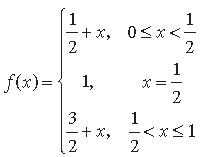
Answer.
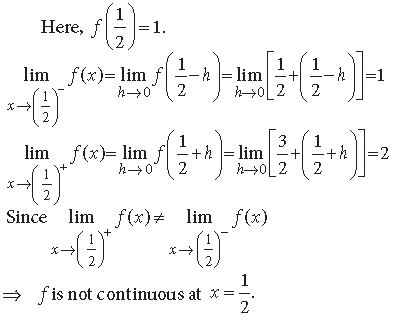
Question.

Answer.
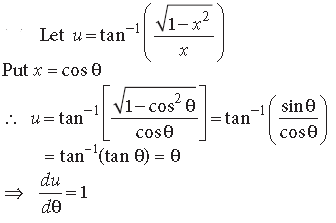
Question. If x = cos t(3 – 2 cos2t) and y = sint (3 – 2 sin2t), find the value of

Answer. Here, x = cos t(3 – 2cos2t), y = sin t(3 – 2 sin2t)

Short Answer Type Questions
Question. Find the values of p and q, for which

Answer. ∴ f(x) is continuous at π/2.

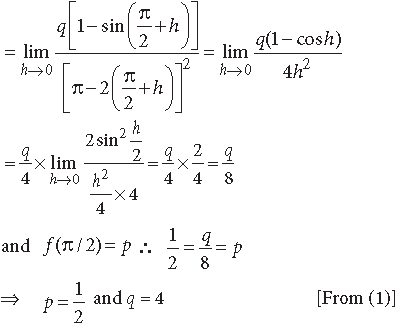
Question. Find the value of the constant k so that the function f, defined below, is continuous at x= 0, where

Answer. ∵ f(x) is continuous at x = 0.
∴ f(0) = k
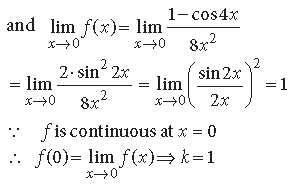
Question. Find the value of k, for which

Answer. ∵ f(x) is continuous at x = 0


Question.

Answer. ∵ f(x) is continuous at x = 0.
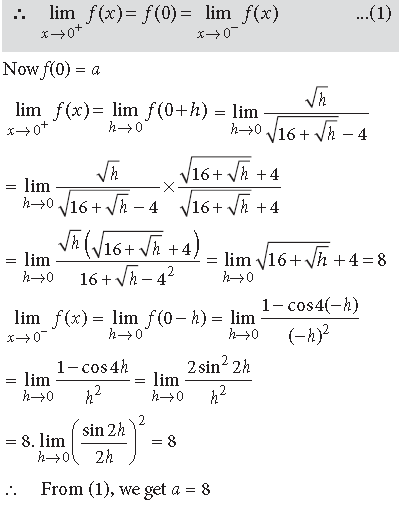
Question.

Find the values of a and b so that f(x) is a continuous function.
Answer. Continuity at x = 3
∵ f (x) is continuous at x = 3

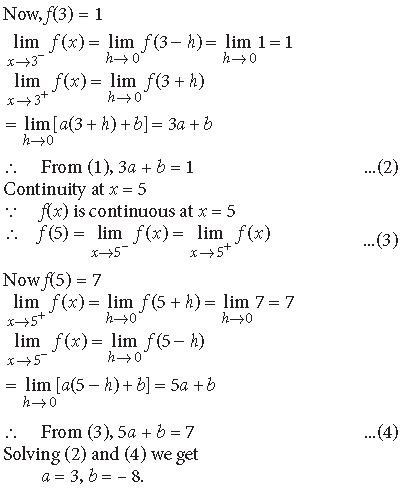
Question. For what value of a is the function f defined by

Answer. ∵ f(x) is continuous at x = 0,

Question. Show that the function f(x) defined by
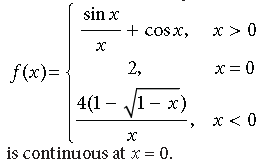
Answer.

Question. If f(x) defined by the following is continuous at x = 0, find the value of a, b and c.
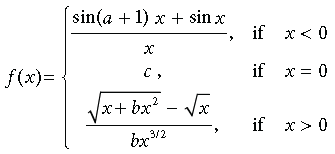
Answer. For f(x) to be continuous at x = 0, we must have


Question. Find the value of k if the function

Answer. ∵ f(x) is continuous at x = 1

Question.
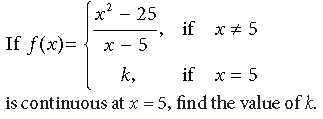
Answer. ∵ f(x) is continuous at x = 5

Question. Find the values of a and b, if the function f

Answer. Given that f(x) is differentiable at x = 1.
Therefore, f(x) is continuous at x = 1


Question.
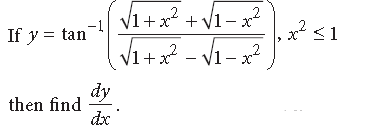
Answer. We have,
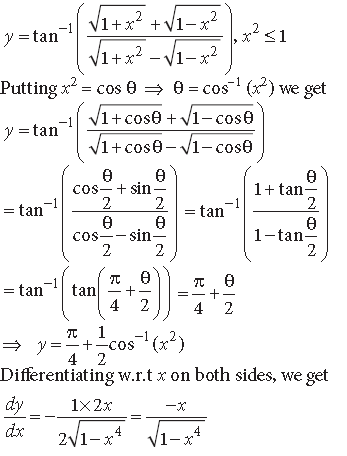
Question.

Answer.

Question. Show that the function f(x) = |x – 1| + |x + 1|, for all x ∈ R, is not differentiable at the points x = –1 and x = 1.
Answer. The given function is f(x) = |x – 1| + |x + 1|
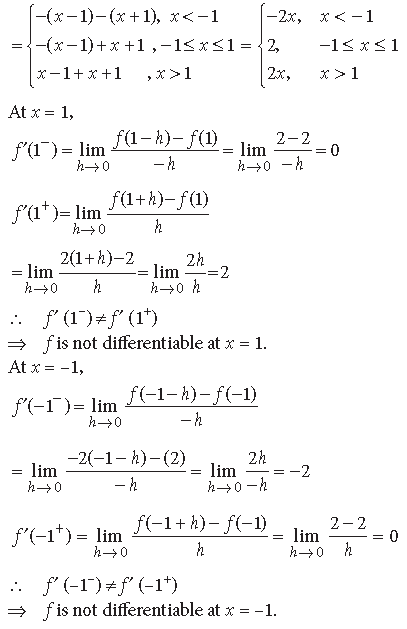
Question. Find whether the following function is differentiable at x = 1 and x = 2 or not.

Answer. At x = 1:

Question. If cosy = xcos(a + y), where cos a ≠ ±1, prove that

Answer. We have cosy = xcos(a + y)
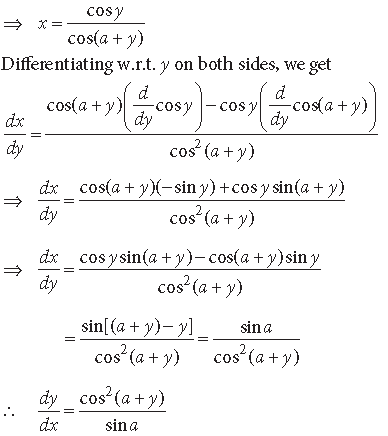
Question.

Answer.

Question. Show that the function f(x) = |x – 3|, x ∈ R, is continuous but not differentiable at x = 3.
Answer.
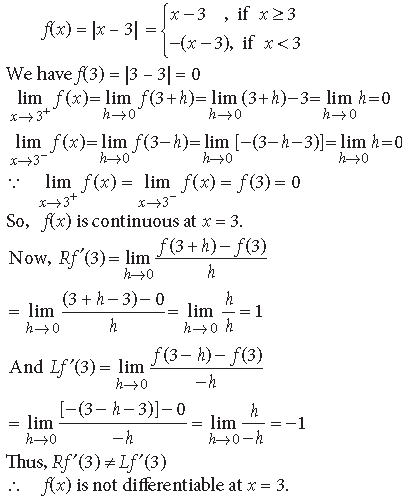
Question.

Answer.

Question.

Answer.

Question. If y = a sin x + b cos x, prove that

Answer. Here, y = a sinx + b cos x
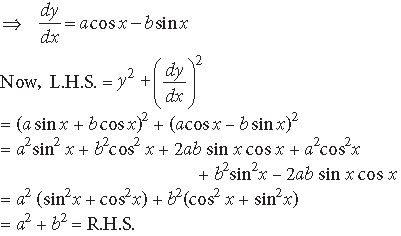
Question. Show that the function defined as follows, is continuous at x = 2, but not differentiable.

Answer.
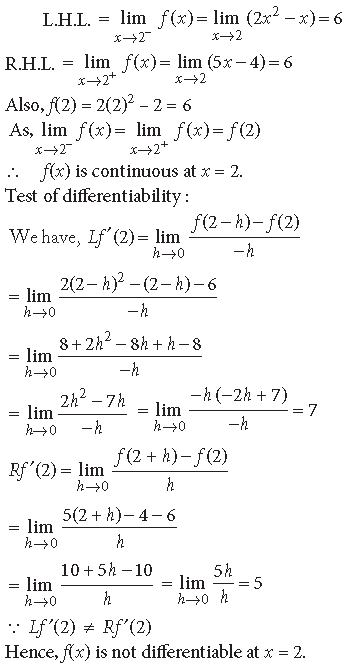
Question.

Answer.

Question.

Answer. We have, (x2 + y2)2 = xy
Differentiating w.r.t. x, we get
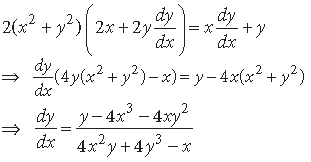
Question.

Answer. We have,

Question.

Answer.

Question. If xy + y2 = tan x + y, find dy/dx
Answer. Given, xy + y2 = tan x + y
Differentiating w.r.t. x, we get
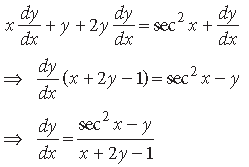
Question.
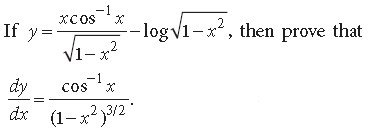
Answer.
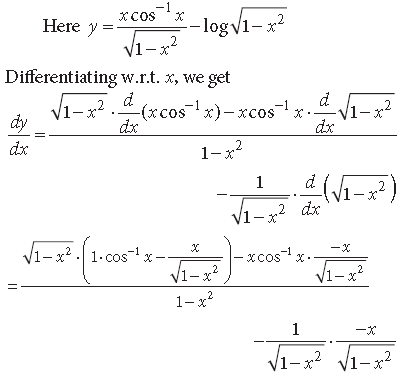

Question. If ex + ey = ex + y, prove that dy/dx + e y − x = 0
Answer. Given ex + ey = ex + y ⇒ 1 + ey–x = ey …(1)
Differentiating (1) w.r.t. x, we get

Question.

Answer.
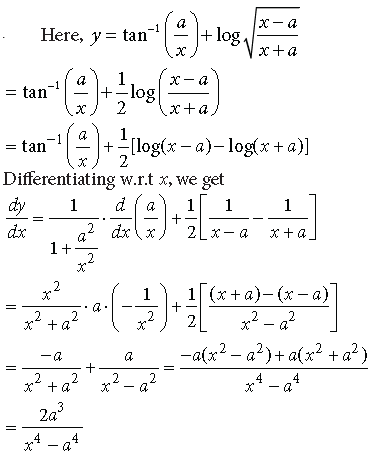
Question.

Answer.
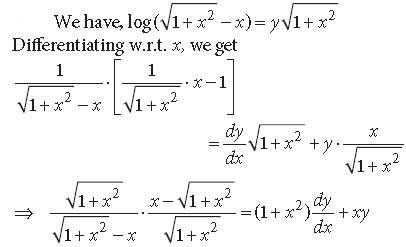

Question.

Answer.

Question.

Answer.
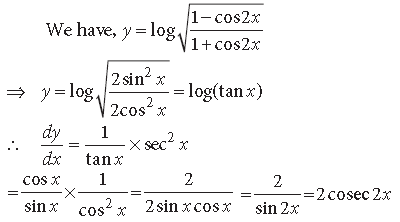
Question. Differentiate xsin x + (sin x)cos x with respect to x.
Answer.
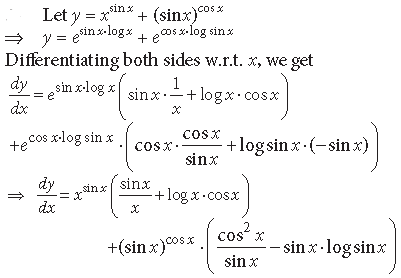
Question. If y = (sinx)x + sin−1 √x, then find dy/dx
Answer.

Question.

Answer.
Given xmyn = (x + y)m + n
Taking log on both the sides, we get
logxm + log yn = (m + n)log (x + y)
⇒ m logx + n log y = (m + n) log (x + y)
Differentiating w.r.t. x, we get

Question.

Answer.
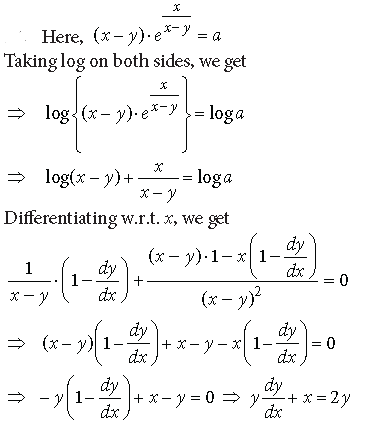
Question. Differentiate the following function with respect to x : (log x)x + xlogx.
Answer. Let y = (log x)x + xlog x
∴ y = ex log (log x) + e(log x)2
Differentiating w.r.t. x, we get
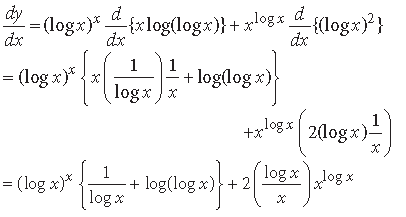
Question.

Answer. Here yx = ey – x
Taking log on both sides, we get
xlog y = (y – x)log e = y – x
⇒ x(1 + logy) = y
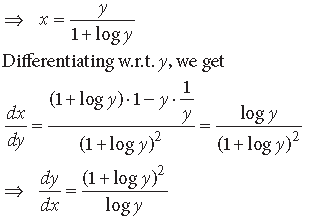
Question. Differentiate the following with respect to x :

Answer.

Question.

Answer. We have, xy = ex–y
Taking log on both sides, we get
y log x =(x – y)log e = x – y
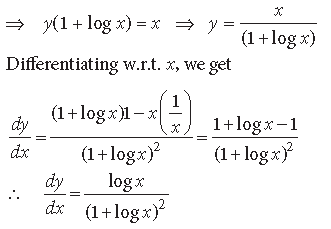
Question. If (cos x)y = (cos y)x, find dy/dx.
Answer. We have, (cos x)y = (cos y)x
Taking log on both sides, we get
y log (cos x) = x log (cos y)
Differentiating w.r.t. x, we get

Question.

Answer.

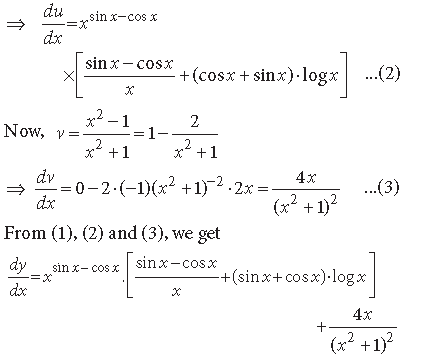
Question. If y = 2cos(log x) + 3sin(log x), prove that

Answer. We have, y = 2 cos (log x) + 3 sin (log x)
Differentiating w.r.t. x, we get
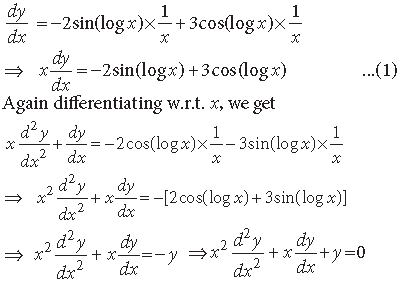
Question. If x = sin t and y = sin pt. Prove that

Answer. We have, x = sin t and y = sin pt
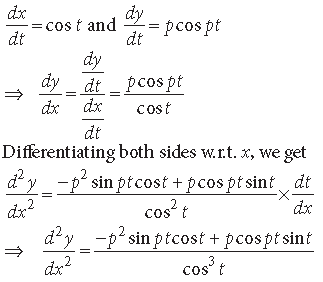

Question.

Answer.
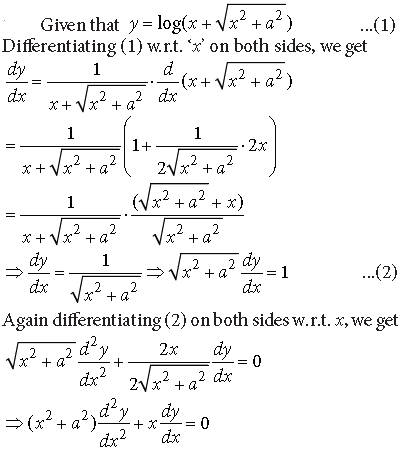
Question. If x = a cos3 θ and y = a sin3 θ, then find the value of

Answer. Here x = a cos3 θy = a sin3 θ

Question.

Answer.

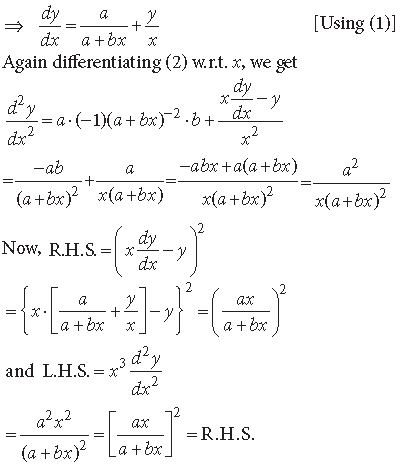
Question. If y = x + tan x, then prove that

Answer. We have, y = x + tan x

Question. Verify Rolle’s theorem for the function f(x) = x2 – 4x + 3 on [1, 3].
Answer. We have, f(x) = x2– 4x + 3
(i) f(x) being a polynomial function is continuous in [1,3]
(ii) f(x) being a polynomial function is differentiable in (1, 3)
(iii) f(3) = 32– 4(3) + 3 = 0 and f(1) = 12 – 4(1) + 3 = 0. Thus f(1) = f(3)
Thus, all the conditions of Rolle’s theorem are satisfied, so there exists atleast one point c ∈(1, 3) such that f'(c) = 0
f ‘(x) = 2x – 4 ⇒ f ‘(c) = 2c – 4
∴ f ‘(c) = 2c – 4 = 0 ⇒ c = 2 ∈(1, 3)
Hence, the Rolle’s theorem is verified.
Long Answer Type Questions
Question. For what value λ of the function defined by

is continuous at x = 0? Hence check the differentiability of f(x) at x = 0.
Answer.
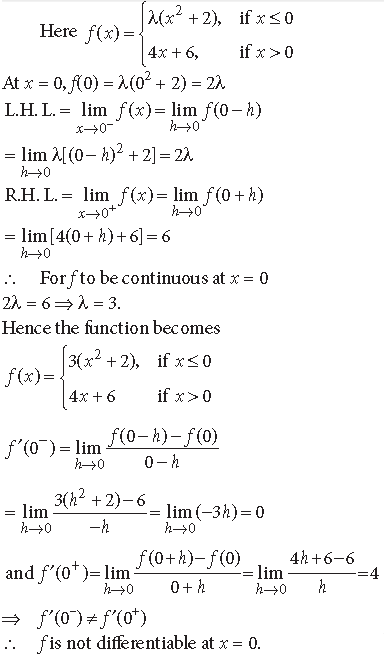
Question. If (tan–1x)y + ycotx = 1, then find dy/dx.
Answer. Here, (tan–1x)y + ycotx = 1
⇒ u + v = 1 where u = (tan–1x)y and v = ycotx
Differentiating w.r.t. x, we get


